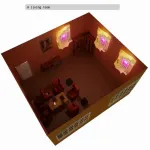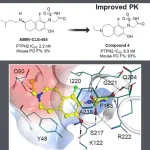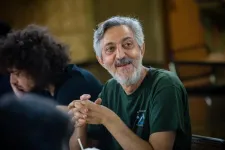(Press-News.org) In Star Trek: The Next Generation, Captain Picard and the crew of the U.S.S. Enterprise leverage the holodeck, an empty room capable of generating 3D environments, to prepare for missions and to entertain themselves, simulating everything from lush jungles to the London of Sherlock Holmes. Deeply immersive and fully interactive, holodeck-created environments are infinitely customizable, using nothing but language: the crew has only to ask the computer to generate an environment, and that space appears in the holodeck.
Today, virtual interactive environments are also used to train robots prior to real-world deployment in a process called “Sim2Real.” However, virtual interactive environments have been in surprisingly short supply. “Artists manually create these environments,” says Yue Yang, a doctoral student in the labs of Mark Yatskar and Chris Callison-Burch, Assistant and Associate Professors in Computer and Information Science (CIS), respectively. “Those artists could spend a week building a single environment,” Yang adds, noting all the decisions involved, from the layout of the space to the placement of objects to the colors employed in rendering.
That paucity of virtual environments is a problem if you want to train robots to navigate the real world with all its complexities. Neural networks, the systems powering today’s AI revolution, require massive amounts of data, which in this case means simulations of the physical world. “Generative AI systems like ChatGPT are trained on trillions of words, and image generators like Midjourney and DALLE are trained on billions of images,” says Callison-Burch. “We only have a fraction of that amount of 3D environments for training so-called ‘embodied AI.’ If we want to use generative AI techniques to develop robots that can safely navigate in real-world environments, then we will need to create millions or billions of simulated environments.”
Enter Holodeck, a system for generating interactive 3D environments co-created by Callison-Burch, Yatskar, Yang and Lingjie Liu, Aravind K. Joshi Assistant Professor in CIS, along with collaborators at Stanford, the University of Washington, and the Allen Institute for Artificial Intelligence (AI2). Named for its Star Trek forebear, Holodeck generates a virtually limitless range of indoor environments, using AI to interpret users’ requests. “We can use language to control it,” says Yang. “You can easily describe whatever environments you want and train the embodied AI agents.”
Holodeck leverages the knowledge embedded in large language models (LLMs), the systems underlying ChatGPT and other chatbots. “Language is a very concise representation of the entire world,” says Yang. Indeed, LLMs turn out to have a surprisingly high degree of knowledge about the design of spaces, thanks to the vast amounts of text they ingest during training. In essence, Holodeck works by engaging an LLM in conversation, using a carefully structured series of hidden queries to break down user requests into specific parameters.
Just like Captain Picard might ask Star Trek’s Holodeck to simulate a speakeasy, researchers can ask Penn’s Holodeck to create “a 1b1b apartment of a researcher who has a cat.” The system executes this query by dividing it into multiple steps: first, the floor and walls are created, then the doorway and windows. Next, Holodeck searches Objaverse, a vast library of premade digital objects, for the sort of furnishings you might expect in such a space: a coffee table, a cat tower, and so on. Finally, Holodeck queries a layout module, which the researchers designed to constrain the placement of objects, so that you don’t wind up with a toilet extending horizontally from the wall.
To evaluate Holodeck’s abilities, in terms of their realism and accuracy, the researchers generated 120 scenes using both Holodeck and ProcTHOR, an earlier tool created by AI2, and asked several hundred Penn Engineering students to indicate their preferred version, not knowing which scenes were created by which tools. For every criterion — asset selection, layout coherence and overall preference — the students consistently rated the environments generated by Holodeck more favorably.
The researchers also tested Holodeck’s ability to generate scenes that are less typical in robotics research and more difficult to manually create than apartment interiors, like stores, public spaces and offices. Comparing Holodeck’s outputs to those of ProcTHOR, which were generated using human-created rules rather than AI-generated text, the researchers found once again that human evaluators preferred the scenes created by Holodeck. That preference held across a wide range of indoor environments, from science labs to art studios, locker rooms to wine cellars.
Finally, the researchers used scenes generated by Holodeck to “fine-tune” an embodied AI agent. “The ultimate test of Holodeck,” says Yatskar, “is using it to help robots interact with their environment more safely by preparing them to inhabit places they’ve never been before.”
Across multiple types of virtual spaces, including offices, daycares, gyms and arcades, Holodeck had a pronounced and positive effect on the agent’s ability to navigate new spaces.
For instance, whereas the agent successfully found a piano in a music room only about 6% of the time when pre-trained using ProcTHOR (which involved the agent taking about 400 million virtual steps), the agent succeeded over 30% of the time when fine-tuned using 100 music rooms generated by Holodeck.
“This field has been stuck doing research in residential spaces for a long time,” says Yang. “But there are so many diverse environments out there — efficiently generating a lot of environments to train robots has always been a big challenge, but Holodeck provides this functionality.”
In June, the researchers will present Holodeck at the 2024 Institute of Electrical and Electronics Engineers (IEEE) and Computer Vision Foundation (CVF) Computer Vision and Pattern Recognition (CVPR) Conference in Seattle, Washington.
This study was conducted at the University of Pennsylvania School of Engineering and Applied Science and at the Allen Institute for Artificial Intelligence (AI2).
Additional co-authors include Fan-Yun Sun, Jiajun Wu, and Nick Haber at Stanford; Ranjay Krishna at the University of Washington; Luca Weihs, Eli Vanderbilt, Alvaro Herrasti, Winson Han, Aniruddha Kembhavi, and Christopher Clark at AI2.
END
Penn Engineers recreate Star Trek’s Holodeck using ChatGPT and video game assets
2024-04-11
ELSE PRESS RELEASES FROM THIS DATE:
UC Santa Cruz researchers value salt marsh restoration as a crucial tool in flood risk reduction and climate resilience in the San Francisco Bay
2024-04-11
Salt marsh restoration can mitigate flood risk and bolster community resilience to climate change in our local waterways, according to a recent study published in Nature by a postdoctoral fellow with UC Santa Cruz’s Center for Coastal Climate Resilience (CCCR).
The study, titled “The value of marsh restoration for flood risk reduction in an urban estuary,” explores the social and economic advantages of marsh restoration amidst the growing threats of sea level rise and storm-driven flooding. Climate change will put many communities at risk. In California, some of the study co-authors from the U.S. Geological ...
Insilico Medicine develops novel PTPN2/N1 inhibitor for cancer immunotherapy using generative AI
2024-04-11
In recent years, cancer immunotherapy, exemplified by PD-1 and its ligand PD-L1 blockade, has made remarkable advances. But while immunotherapy drugs offer new treatment possibilities, only about 20% to 40% of patients respond to these treatments. The majority either don't respond or develop drug resistance. Researchers are now looking for ways to enhance the scope of tumor immunotherapy in order to benefit a wider range of patients.
One such avenue is through the protein tyrosine phosphatase non-receptor type 2 (PTPN2) and its close superfamily member, PTPN1, identified in previous research as crucial modulators involved in the regulation ...
$318 million New York City community parks initiative is associated with increased use of urban parks in low-income neighborhoods
2024-04-11
A new study in JAMA Network Open led by researchers from the CUNY Graduate School of Public Health and Health Policy observed 28,322 park users across 54 neighborhood parks and found a clear association between park renovation and park use in low-income neighborhoods in New York City (NYC).
As the global trend toward urbanization continues, two thirds of the world’s population is predicted to live in cities by 2050. Amid the noise, stress, and crowding of city life, urban parks have the potential to provide opportunities for physical activity, mitigate heat and pollution, lower stress, and improve mental and social well-being, all of which can decrease the prevalence ...
Trapped in the middle: billiards with memory
2024-04-11
Adding one simple rule to an idealized game of billiards leads to a wealth of intriguing mathematical questions, as well as applications in the physics of living organisms. This week, researchers from the University of Amsterdam, including two master students as first authors – have published a paper in Physical Review Letters about the fascinating dynamics of billiards with memory.
Billiards: a mathematical mystery
An idealized version of the game of billiards has fascinated mathematicians for decades. The basic ...
A new spin on organic shampoo makes it sudsier, longer lasting
2024-04-11
While there’s no regulation in the U.S. for what’s in organic shampoos, they tend to contain ingredients perceived as safe or environmentally friendly. However, these “clean” shampoos separate and spoil faster than those made with synthetic stabilizers and preservatives. Now, researchers in ACS Sustainable Chemistry & Engineering demonstrate that a simple process — spinning organic shampoo at high speeds — improved the final products’ shelf lives and ability to clean hair.
Natural emulsifiers, such as xanthan gum and cetyl alcohol, ...
Nanoscale movies shed light on one barrier to a clean energy future
2024-04-11
DURHAM, N.C. -- Left unchecked, corrosion can rust out cars and pipes, take down buildings and bridges, and eat away at our monuments.
Corrosion can also damage devices that could be key to a clean energy future. And now, Duke University researchers have captured extreme close-ups of that process in action.
“By studying how and why renewable energy devices break down over time, we might be able to extend their lifetime,” said chemistry professor and senior author Ivan Moreno-Hernandez.
In his lab at Duke sits a miniature version of one such device. Called an electrolyzer, ...
American College of Lifestyle Medicine announces first two medical schools to earn highest recognition and certification for lifestyle medicine curriculum
2024-04-11
The American College of Lifestyle Medicine (ACLM) has announced that the University of South Carolina School of Medicine Greenville (SOMG) and Loma Linda University School of Medicine (LLUSM) are the first to earn the highest recognition of a “Platinum Plus” certification designation for the significant level of undergraduate lifestyle medicine curricula within their programs.
The Platinum Plus is the highest tier of certification that a medical school can receive from ACLM and indicates the incorporation of at least 100 hours of evidence-based lifestyle medicine content within the curriculum. This level of lifestyle medicine ...
Avi Wigderson receives ACM A.M. Turing Award for groundbreaking insights on randomness
2024-04-11
ACM, the Association for Computing Machinery, today named Avi Wigderson as recipient of the 2023 ACM A.M. Turing Award for foundational contributions to the theory of computation, including reshaping our understanding of the role of randomness in computation, and for his decades of intellectual leadership in theoretical computer science.
Wigderson is the Herbert H. Maass Professor in the School of Mathematics at the Institute for Advanced Study in Princeton, New Jersey. He has been a leading figure in areas including computational complexity theory, algorithms and optimization, randomness and cryptography, parallel and distributed computation, combinatorics, and graph theory, as well as ...
NAWI awarded funding to continue to accelerate research and development for a secure water future
2024-04-11
– By Lauren Core
The National Alliance for Water Innovation (NAWI), which is led by the Department of Energy’s (DOE) Lawrence Berkeley National Laboratory (Berkeley Lab), has been extended for five more years with $75 million in funding from DOE. NAWI will continue its contributions to helping decarbonize the water and wastewater sectors through investments in technologies that enhance the efficient use of energy for water use, treatment, and distribution.
“Water and energy are interdependent – water is used to produce nearly every major energy source, and ...
2024 Research Fellowship Awards to support three exciting disease intervention research projects
2024-04-11
Systems Biology Ireland (SBI) at University College Dublin (UCD) and The Quantitative Biosciences Institute (QBI) at the University of California, San Francisco (UCSF), and) have announced the 2024 winners of the joint Research Fellowship Awards (RFAs).
The Research Fellowship Awards aim to support collaborative high quality and ground -breaking research proposals from QBI-UCSF and UCD in the areas of network biology and drug/drug target discovery.
The winning projects for 2024 are:
“Overcoming Resistance to HER2-Targeted Therapies in Breast Cancer,” ...





